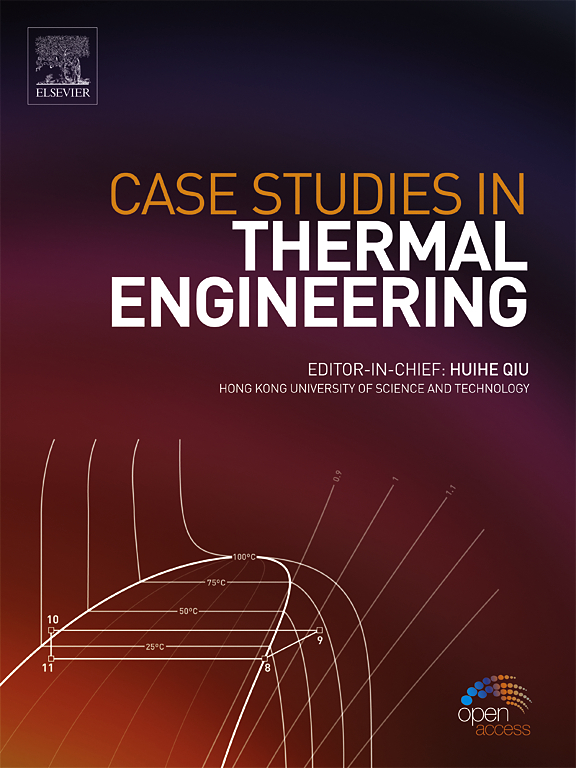Numerical analysis and experimental study of two-phase flow pattern and pressure drop characteristics in internally microfin tubes
IF 6.4
2区 工程技术
Q1 THERMODYNAMICS
引用次数: 0
Abstract
Microfin tubes with internal structures exhibit superior thermo-hydraulic performance, making them indispensable in systems such as air conditioning, chemical industry, and heat pumps. Despite their widespread application, research on microfin tubes has predominantly concentrated on single-phase flows. The heat transfer coefficient of phase change heat transfer is much higher than that of single-phase heat transfer. The higher heat transfer coefficient enables micro finned tubes using phase change heat transfer to significantly improve heat transfer efficiency while reducing equipment size. The understanding of gas-liquid two-phase flow characteristics is crucial for heat and mass transfer rates and pressure drop. This study examines the two-phase flow patterns and pressure drop characteristics within microfin tubes, considering variables such as two-phase Reynolds number (200≤Re ≤ 600), gas void fraction (0.3≤ζ ≤ 0.55), tube inner diameter (2.5≤d ≤ 5 mm), helix angle (0°≤β ≤ 36°), and microfin count (20≤Ns ≤ 60) through both experimental and numerical approaches. The findings reveal that the inlet Reynolds number and microfin count exert negligible effects on bubble dimensions and morphology. As the gas void fraction and helix angle increase, the gas-liquid interfacial profiles become more symmetric. The influence of changes in bubble length and gas void fraction on bubble velocity can be ignored. When the helix angle is 18°, friction resistance factor in the liquid column region is the minimum of 0.04. The friction resistance factor in the liquid column region decreases with the increase of two-phase Reynolds number and microfin count, and decreases with the decrease of gas void fraction and tube inner diameter.
内部微鳍管内两相流模式和压降特性的数值分析和实验研究
具有内部结构的微鳍管具有卓越的热液性能,因此在空调、化学工业和热泵等系统中不可或缺。尽管微鳍管应用广泛,但对其的研究主要集中在单相流方面。相变传热的传热系数远高于单相传热。较高的传热系数使得利用相变传热的微型翅片管能够显著提高传热效率,同时缩小设备尺寸。了解气液两相流特性对传热、传质速率和压降至关重要。本研究通过实验和数值方法,考虑了两相雷诺数(200≤Re≤600)、气体空隙率(0.3≤ζ≤0.55)、管内径(2.5≤d≤5 毫米)、螺旋角(0°≤β≤36°)和微鳍数量(20≤Ns≤60)等变量,研究了微鳍管内的两相流动模式和压降特性。研究结果表明,入口雷诺数和微鳍数对气泡尺寸和形态的影响微乎其微。随着气体空隙率和螺旋角的增加,气液界面轮廓变得更加对称。气泡长度和气体空隙率的变化对气泡速度的影响可以忽略。当螺旋角为 18°时,液柱区域的摩擦阻力系数最小,为 0.04。液柱区的摩擦阻力因子随两相雷诺数和微鳍数的增加而减小,随气体空隙率和管内径的减小而减小。
本文章由计算机程序翻译,如有差异,请以英文原文为准。
求助全文
约1分钟内获得全文
求助全文
来源期刊

Case Studies in Thermal Engineering
Chemical Engineering-Fluid Flow and Transfer Processes
CiteScore
8.60
自引率
11.80%
发文量
812
审稿时长
76 days
期刊介绍:
Case Studies in Thermal Engineering provides a forum for the rapid publication of short, structured Case Studies in Thermal Engineering and related Short Communications. It provides an essential compendium of case studies for researchers and practitioners in the field of thermal engineering and others who are interested in aspects of thermal engineering cases that could affect other engineering processes. The journal not only publishes new and novel case studies, but also provides a forum for the publication of high quality descriptions of classic thermal engineering problems. The scope of the journal includes case studies of thermal engineering problems in components, devices and systems using existing experimental and numerical techniques in the areas of mechanical, aerospace, chemical, medical, thermal management for electronics, heat exchangers, regeneration, solar thermal energy, thermal storage, building energy conservation, and power generation. Case studies of thermal problems in other areas will also be considered.
 求助内容:
求助内容: 应助结果提醒方式:
应助结果提醒方式:


